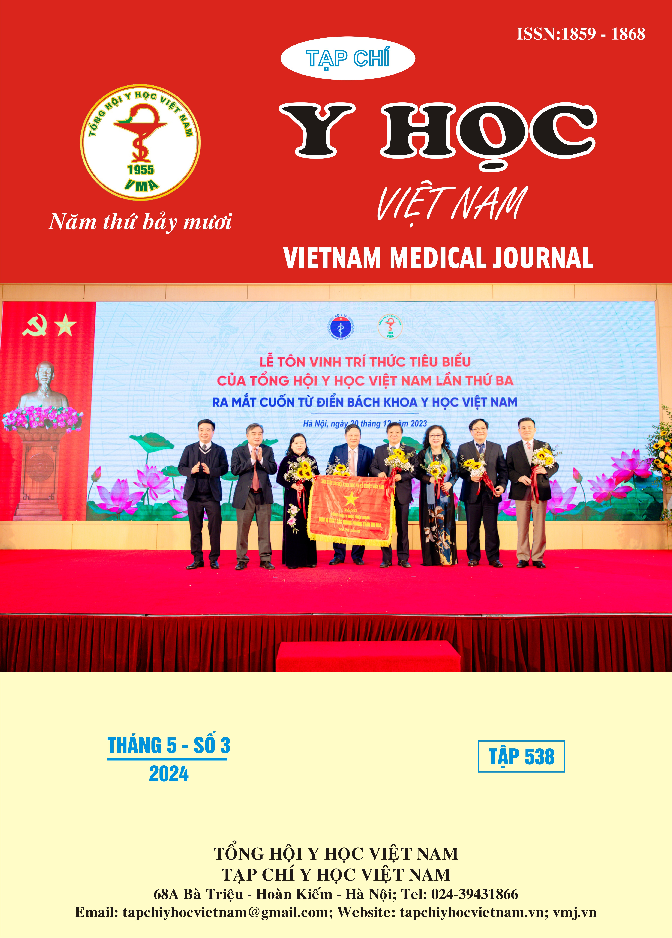CLINICAL CHARACTERISTICS, MICROBIOLOGY, AND PATHOLOGY OF PATIENTS WITH CORNEAL ULCER AT EYE HOSPITAL AT HO CHI MINH CITY
Main Article Content
Abstract
Background: Corneal ulcers are the most common cause of blindness in Vietnam. But most of the reports focus on evaluating the results of treatment of corneal ulcers, while also examining paraclinical characteristics related to prognostic factors and the suitability of paraclinical results to find microbial agents. birth in diagnosis has not been described much. Objective: Determine the paraclinical, microbiological and pathological characteristics of patients with corneal ulcers at Ho Chi Minh City Eye Hospital. Methods: The study describes a series of cases, retrospectively examining medical records of patients diagnosed with infectious corneal ulcers and treated as inpatients at the Cornea Department, Ho Chi Minh City Eye Hospital. Results: The study found that fungi and bacteria are the most common, of which bacteria account for 40.0% and fungi account for 25.0%. Of the 40 cases, 27 cases involved bacteria causing corneal ulcers. Only 4 cases grew bacteria by culture (accounting for 14.8%). Performing RT-PCR on 26 patient samples, in 14 cases of corneal ulcers with bacteria, 10 cases were positive for bacteria, accounting for 38.5% (10/26) and sensitivity of 71.4. % (10/14). In the study sample, the positive rate of the virus was 23.1%, with 1 case due to Aspergillus niger (3.8%). Conclusion: Laboratory results of fresh examination, culture and RT PCR before and after surgery were not consistent with each other.
Article Details
Keywords
Paraclinical, microbiology, pathology, corneal ulcers, Ho Chi Minh City Eye Hospital
References
2. Whitcher J.P., M. Srinivasan, M. P. Upadhyay (2001), "Corneal blindness: a global perspective", Bull World Health Organ. 79(3), pp. 214-21
3. Ung L., et al (2019). “The persistent dilemma of microbial keratitis: Global burden, diagnosis, and antimicrobial resistance.” Surv Ophthalmol. 64(3): 255-271
4. Lê Anh Tâm (2008). “Nghiên cứu tình hình viêm loét giác mạc tại Bệnh viện Mắt Trung ương trong 10 năm (1998 – 2007)”. Luận văn thạc sỹ Y học chuyên ngành Nhãn Khoa, Trường Đại học Y Hà Nội.
5. Trần Ngọc Huy (2020). “Khảo sát tác nhân viêm loét giác mạc nhiễm trùng tại bệnh viện mắt thành phố Hồ Chí Minh”. Luận văn thạc sĩ Y học chuyên ngành Nhãn khoa, Đại học Y Dược Tp. Hồ Chí Minh.
6. Vũ Hoàng Việt Chi (2012). “Viêm loét giác mạc nhiễm trùng tại bệnh viện Mắt Trung Ương: Đặc điểm lâm sàng và vi sinh”. Tạp chí Nhãn khoa Việt Nam. 29: 28-34
7. Marangon F B, Miller D, Alfonso E C, (2004), "Impact of prior therapy on the recovery and frequency of corneal pathogens", Cornea, 23 (2), pp. 158-164
8. Kim E, Chidambaram J.D, Srinivasan M, Lalitha P, et al (2008). “Prospective comparison of microbial culture and polymerase chain reaction in the diagnosis of corneal ulcer”. Am J Ophthalmol.146(5): 714-723
9. Parisa Taravati, Deborah Lam, Russell N. Van Gelder (2013). “Role of Molecular Diagnostics in Ocular Microbiology”. Current Ophthalmology Reports.Vol 1: 181–189.
10. Jeremy J. Hoffman, John K.G. Dart, Surjo K. De, et al (2022). “Comparison of culture, confocal microscopy and PCR in routine hospital use for microbial keratitis diagnosis”. Eye. Vol. 36: 2172–2178.


